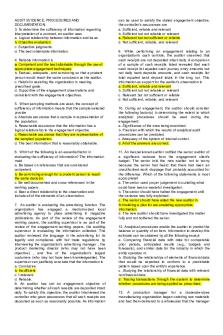Operational Auditing PDF

| Title | Operational Auditing |
|---|---|
| Author | Csaba Matko |
| Course | Internal Auditing |
| Institution | Eastern Michigan University |
| Pages | 3 |
| File Size | 86.5 KB |
| File Type | |
| Total Downloads | 49 |
| Total Views | 150 |
Summary
Operational Auditing...
Description
OPERATIONAL AUDITING I.
DEFINITION Operational auditing is the systematic process of evaluating an organization’s effectiveness, efficiency, and economy of operations under management’s control, and reporting the results of evaluations with recommendations for improvement.
II.
CHARACTERISTICS A.
Purpose 1. To help all levels of management improve planning and control by identifying aspects of systems and procedures to improve and make recommendations. 2.
B.
C.
To place emphasis on helping future performance (financial emphasis on past compliance, past adherence).
Independence 1. Free of personal involvement/responsibility of the audited unit - although managers may assist in the evaluation process through participative auditing 2.
Develop programs without undue influence or pressure
3.
Full access to evidence/personnel
4.
Objective in gathering and evaluating evidence
5.
Able to report all matters deemed necessary
Systematic Approach 1. Well-planned 2.
Comprehensive understanding
D.
Performance Criteria 1. Established standards 2.
E.
Environment Objectives Evidence Conclusions Reporting Follow-up
Comparison
3. Develop reasonable criteria in absence of standards Audit Evidence
F.
1.
Theory of evidence
2.
Collection techniques
Reporting and Recommending 1. Evaluate and report 2.
III.
Make recommendation to improve (must consider usefulness of recommendation -- most important aspect of operational audit)
FIVE PHASES OF OPERATIONAL AUDIT
Preliminary Preparation A.
Field Survey
Preliminary Preparation 1. Study and evaluate available information
B.
C.
Program Audit Development Application
Industry Input markets of firm Output markets of firm Production technology Control and regulation (internal & external) Management style, characteristics, and values Organizational structure Geographic distribution Production process Reporting, planning, and control systems
2.
Develop background files Charters Organizational charts Policy & procedures manuals Budgets Financial statements Systems descriptions Audit reports and memos
3.
Perform analytical procedures
Field Survey - determines scope/emphasis--on site - pinpoints specific problems 1. Interviewing key personnel 2.
Reviewing systems/reports
3.
Observing operations
Program Development 1. Documents audit planning/control of audit 2
Report & Follow-up
D.
2.
Guide for evidence collection
3.
Should be written -- individually designed
4.
Links audit objectives with procedures
Audit Application (most time consuming phase) 1. Step-by-step completion of program 2.
Process - should be flexible and modifiable depending on findings Gather and analyze Draw conclusions Develop recommendations Show cause and effect Document in workpapers
E.
Reporting and follow-up 1. Reporting - only report what can be documented
State facts precisely and clearly Support conclusions with findings Practical recommendations that address problems Review with auditee
e.g.
2.
background scope opinions findings recommendations replies by auditee
Follow-up What actions were taken Management decisions on whether to taken action Report open until auditor satisfied us to actions Policy developed by upper management reporting timely response to audit report
3...
Similar Free PDFs

Operational Auditing
- 3 Pages

Operational Management
- 1 Pages

Auditing
- 31 Pages

Auditing
- 9 Pages

Auditing
- 10 Pages

Operational Issues
- 4 Pages

Auditing
- 1 Pages

Operational management-Apple Inc
- 14 Pages

Manage operational plan
- 30 Pages

POLICE OPERATIONAL PLANNING 1
- 140 Pages
Popular Institutions
- Tinajero National High School - Annex
- Politeknik Caltex Riau
- Yokohama City University
- SGT University
- University of Al-Qadisiyah
- Divine Word College of Vigan
- Techniek College Rotterdam
- Universidade de Santiago
- Universiti Teknologi MARA Cawangan Johor Kampus Pasir Gudang
- Poltekkes Kemenkes Yogyakarta
- Baguio City National High School
- Colegio san marcos
- preparatoria uno
- Centro de Bachillerato Tecnológico Industrial y de Servicios No. 107
- Dalian Maritime University
- Quang Trung Secondary School
- Colegio Tecnológico en Informática
- Corporación Regional de Educación Superior
- Grupo CEDVA
- Dar Al Uloom University
- Centro de Estudios Preuniversitarios de la Universidad Nacional de Ingeniería
- 上智大学
- Aakash International School, Nuna Majara
- San Felipe Neri Catholic School
- Kang Chiao International School - New Taipei City
- Misamis Occidental National High School
- Institución Educativa Escuela Normal Juan Ladrilleros
- Kolehiyo ng Pantukan
- Batanes State College
- Instituto Continental
- Sekolah Menengah Kejuruan Kesehatan Kaltara (Tarakan)
- Colegio de La Inmaculada Concepcion - Cebu





